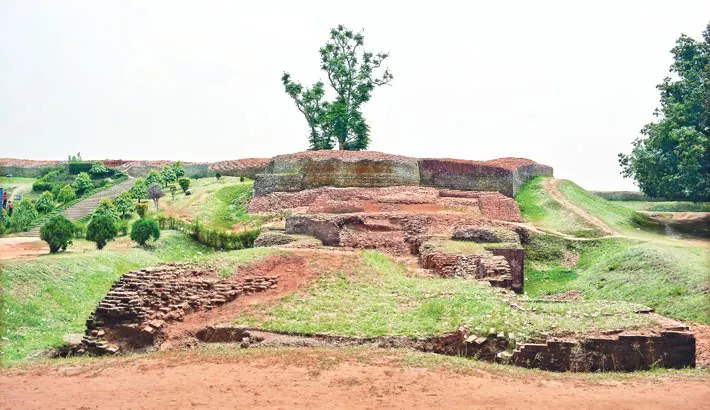Mahasthangarh
Mahasthangarh (Bengali: মহাস্থানগড় Môhasthangôṛ) is one of the soonest urban archeological locales so far found in Bangladesh. The town Mahasthan in Shibganj thana of Bogra District contains the remaining parts of an old city which was called Pundranagara or Paundravardhanapura in the region of Pundravardhana.[1][2][3] A limestone section bearing six lines in Prakrit in Brahmi content, found in 1931, dates Mahasthangarh to in any event the third century BC.[4] The strengthened region was being used until the eighteenth century AD.[2]

Etymology
Mahasthan implies a place that has phenomenal sacredness and garh implies stronghold. Mahasthan was first said in a Sanskrit content of the thirteenth century entitled Vallalcharita. It is likewise said in an unknown content Karatoya mahatmya, incidentally set in 12th– thirteenth century. A similar content likewise specifies two more names to mean a similar place – Pundrakshetra, place that is known for the Pundras, and Pundranagara, city of the Pundras. In 1685, an authoritative pronouncement specified the place as Mastangarh, a blend of Sanskrit and Persian importance strengthened place of a promising personage. Resulting revelations have affirmed that the before name was Pundranagara or Paundravardhanapura, and that the present name of Mahasthangarh is of later origin.[5]
Geography
Mahasthangarh, the antiquated capital of Pundravardhana is found 11 km (6.8 mi) north of Bogra on the Bogra-Rangpur interstate, with a feeder street (running along the eastern side of the bulwarks of the fortification for 1.5 km) prompting Jahajghata and site museum.[6] Busses are accessible for Bogra from Dhaka and take 4½ hours for the adventure by means of Bangabandhu Jamuna Bridge over the Jamuna River. Transports are accessible from Bogra to Mahasthangarh. Rickshaws are accessible for neighborhood development. Procured transport is accessible at Dhaka/Bogra. Convenience is accessible at Bogra.[7] When going in an employed auto, one can come back to Dhaka that day, unless some individual has an arrangement to visit Somapura Mahavihara at Paharpur in the locale of Naogaon and different places, or participate in a point by point examine.
It is trusted that the area for the city in the zone was settled on in light of the fact that it is one of the most astounding regions in Bangladesh. The land in the locale is very nearly 36 meters (118 ft) above ocean level, while Dhaka, the capital of Bangladesh, is around 6 meters (20 ft) above ocean level. Another purpose behind picking this place was the position and size of the Karatoya, which as of late as in the thirteenth century was three times more extensive than Ganges.[8]
Mahasthangarh remains on the red soil of the Barind Tract which is marginally lifted inside the to a great extent alluvium zone. The rise of 15 to 25 meters over the encompassing zones makes it a moderately surge free physiographic unit.[9]
Discovery
A few identities added to the revelation and ID of the remains at Mahasthangarh. Francis Buchanan Hamilton was the first to find and visit Mahasthangarh in 1808, C.J.O'Donnell, E.V.Westmacott, and Beveridge took after. Alexander Cunningham was the first to distinguish the place as the capital of Pundravardhana. He went by the site in 1879.[5]

Citadel
The fortification (see delineate), the invigorated heart of the antiquated city, is rectangular in design, estimating around 1.523 kilometers (0.946 mi) long from north to south, and 1.371 kilometers (0.852 mi) from east to west, with high and wide defenses in every one of its wings. Region of the stronghold is roughly 185 ha.[8] The Karatoya, once a compelling waterway yet now a little stream, streams on its east.[2]
Till the 1920s, when unearthings began, within the stronghold was higher than the encompassing territories by more than 4 meters and was spotted with a few straggling lifted parcels. The bulwark resembled a wilderness clad mud defense with constrained openings at a few focuses. The defense was 11– 13 meters (36– 43 ft) higher than the encompassing region. At its south-east corner stood a mazhar (heavenly tomb). A later day mosque (worked in 1718– 19) was additionally there.[5]
At introduce there are a few hills and basic remnants inside the strongholds. Of these a couple of note are: Jiat Kunda (well which, as indicated by legends, has nurturing power), Mankalir Dhap (put blessed to Mankali), Parasuramer Basgriha (royal residence of a lord named Parasuram), Bairagir Bhita (castle of a female anchorite), Khodar Pathar Bhita (place of stone presented by God), and Munir Ghon (a bastion). There are some doors at various focuses: Kata Duar (in the north), Dorab Shah Toran (in the east), Burir Fatak (in the south), and Tamra Dawaza (in the west)[2] At the north-eastern corner there is a flight of steps (a later expansion) that passes by the name of Jahajghata. A little past Jahajghata and on the banks of the Karatoya is Govinda Bhita (a sanctuary devoted to Govinda). Before it is the site exhibition hall, showing a portion of the delegate discoveries. Close to it is a rest house.